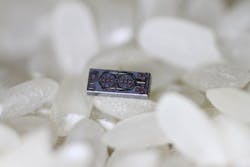Nanophotonic optical gyroscope is 500 times smaller than current devices
Most cell phones today contain a microelectromechanical systems (MEMS) sensor that measures changes in the forces acting on two identical masses that are oscillating and moving in opposite directions. These MEMS gyroscopes are limited in their sensitivity, so optical gyroscopes have been developed to perform the same function but with no moving parts and a greater degree of accuracy using the Sagnac effect.
To create the Sagnac effect (named after French physicist Georges Sagnac), a beam of light is split; the twin beams travel in opposite directions along a circular pathway, then meet at the same photodetector. Rotating the device (and with it the pathway that the light travels) causes one of the two beams to arrive at the detector before the other. With a loop for each axis of orientation (x, y, and z), this phase shift (the Sagnac effect) can be used to calculate orientation. But the smallest high-performance optical gyroscopes available today are bigger than a golf ball and are not suitable for many portable applications.
As optical gyroscopes are built smaller and smaller, so too is the signal that captures the Sagnac effect, which makes it more and more difficult for the gyroscope to detect movement. Up to now, this has prevented the miniaturization of optical gyroscopes. Engineers at Caltech (Pasadena, CA), led by professor Ali Hajimiri, have developed a new optical gyroscope that is 500 times smaller than the current state-of-the-art device, yet can detect phase shifts that are 30 times smaller than those systems.1
Reciprocal sensitivity enhancement
The new gyroscope achieves this improved performance by using a new technique called "reciprocal sensitivity enhancement." Because the Sagnac effect relies on detecting a difference between the two beams as they travel in opposite directions, it is considered nonreciprocal.
Inside the gyroscope, light travels through miniaturized optical waveguides; imperfections in the optical path that might affect the beams (for example, thermal fluctuations or light scattering) and any outside interference will affect both beams similarly. Hajimiri's team found a way to weed out this reciprocal noise while leaving signals from the Sagnac effect intact. Reciprocal sensitivity enhancement thus improves the signal-to-noise ratio in the system and enables the integration of the optical gyro onto a chip on the order of 1.5 x 4 mm in size.
REFERENCE:
1. Parham P. Khial, Alexander D. White, and Ali Hajimiri, Nature Photonics (2018); https://doi.org/10.1038/s41566-018-0266-5.
About the Author
John Wallace
Senior Technical Editor (1998-2022)
John Wallace was with Laser Focus World for nearly 25 years, retiring in late June 2022. He obtained a bachelor's degree in mechanical engineering and physics at Rutgers University and a master's in optical engineering at the University of Rochester. Before becoming an editor, John worked as an engineer at RCA, Exxon, Eastman Kodak, and GCA Corporation.

